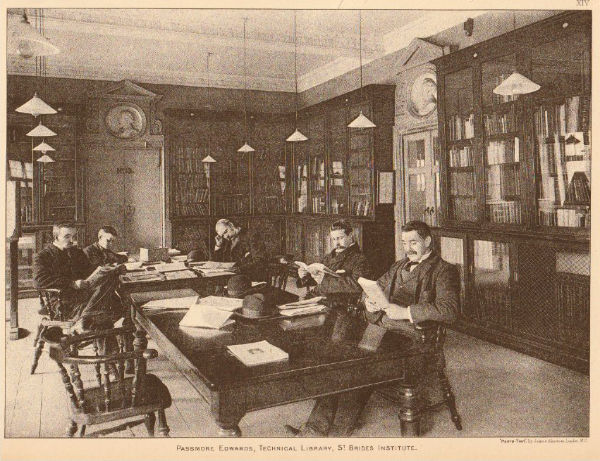The St Bride Library was an integral part of the St Bride Foundation formed, in 1891, through a union of several local London parish charities with the aim of providing ‘social, cultural and educational facilities within Fleet Street and the surrounding areas’.

History
After opening a printing school in 1894 the Foundation decided to create a reference library to support the school. The Governors were fortunate in being able to purchase the library of William Blades, the printer and bibliographer who had died in 1890, and this formed the basis of the technical reference library. However, they were also in need of modern works on printing, paper making, stereotyping, binding and other allied trades and so approached Passmore Edwards for assistance. He responded within days to say he would ‘cheerfully comply with your request’ offering £500; £400 for works already published and £100 set aside for Technical books published in the future.
Sir Walter Besant, the novelist and historian, opened the two libraries, the William Blades Library and the Passmore Edwards Library in November 1895. At the same time, William Blades’ widow and Eleanor Edwards unveiled terracotta medallion portraits of the two men fixed above the doorways to the libraries.
When in 1922 the Printing School moved to Southwark to form the nucleus of the London School of Printing (and Kindred Trades), later to become the London College of Communication, the Technical Reference Library remained at the Institute, and was formally renamed the St Bride Printing Library in 1952.
The Corporation of London took over management of the Library in 1966, offering both the Library and Foundation financial stability but this support was withdrawn in 2004 and management and ownership of the collections was returned to the St Bride Foundation. There was short time when the library closed and it was thought that the resources might be dispersed but with a successful Crowdfunding campaign the library was reopened. The Library celebrated its 125th anniversary on 20 November 2020.
Current Use
The Library remains open to the public as the world’s foremost printing and graphic arts library, with its collection of early printed books, typefaces, rare newspapers and an archive covering the history of printing. The original Institute building included a swimming pool which has since been converted to form the Bridewell Theatre, whilst other rooms have been transformed into lecture rooms, exhibition space and meeting rooms, one of which is called the Passmore Edwards Room. A bust of Samuel Richardson, the novelist, was presented to the Library by Edwards and remains in place today, looking down on visitors as they enter the library.